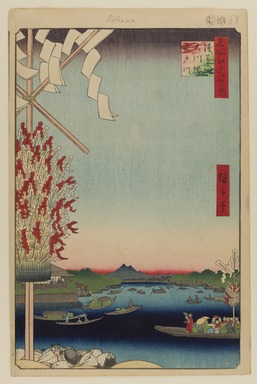
Artist:Utagawa Hiroshige
Medium: Woodblock print
Geograhical Locations:
Dates:7th month of 1857
Dimensions: Sheet: 14 5/16 x 9 5/16 in. (36.4 x 23.7 cm) Image: 13 x 8 1/2 in. (33 x 21.6 cm)
Collections:
Exhibitions:
Accession Number: 30.1478.60
Image: 30.1478.60_PS20.jpg,
Catalogue Description: A view of one of the more interesting summer customs associated with the Ryogoku Bridge, the ablutions of the Mount Oyama pilgrims. The pilgrims rinsed themselves in the waters of the Sumida as an act of ritual purification before journeying to the sacred Mount Oyama, some forty miles to the south. The ritual was designed to greet the summer by purging the noxious spirits of the season. This view shows two groups of pilgrims returning by boat from the ablution site to the boat landing at Yanagibashi, where the Kanda River flows into the Sumida (suggested by the horizontal bank of deep blue). The yamabushi or mountain ascetics were responsible for the spread of the Oyama cult through the Kanto region, recruiting groups of pilgrims to climb the mountain. As they crossed the river, the pilgrims chanted ritual phrases and after their ablutions would proceed through the streets of downtown Edo, distributing the gohei (ritual paper strips). There is confusion regarding the title of this print because Asukagawa, Okawa and Mitayogawa are all alternate names for the Sumida River. (The title of the print was changed in later printings to "In Boats at Ryogoku with a Distant View of Asakusa.")